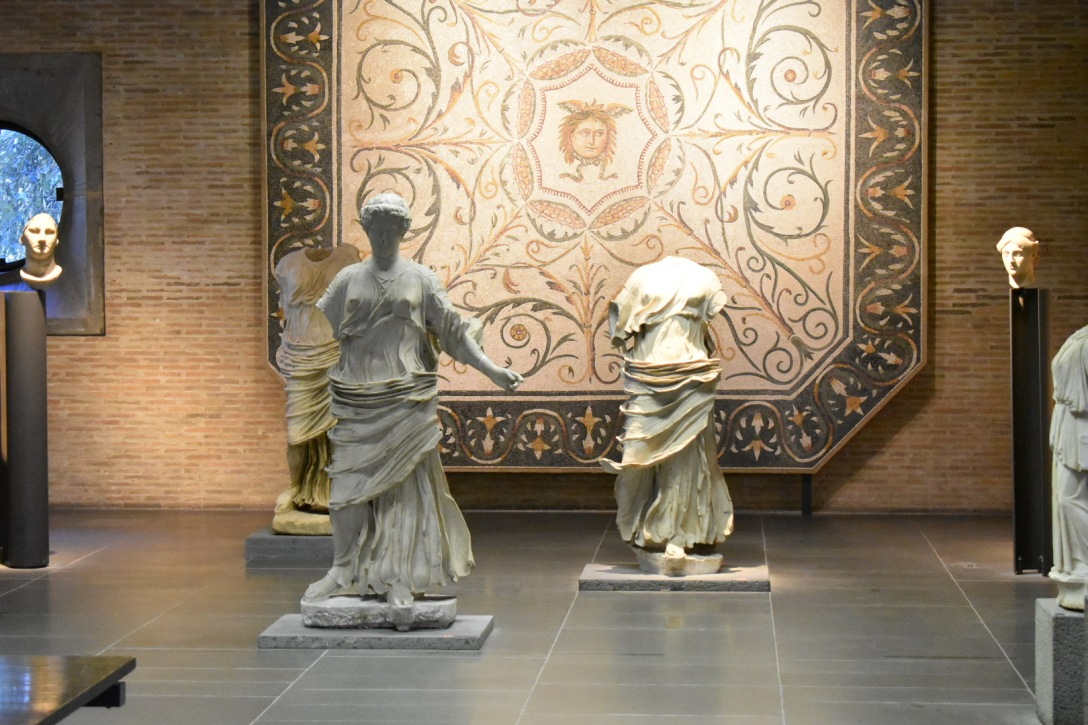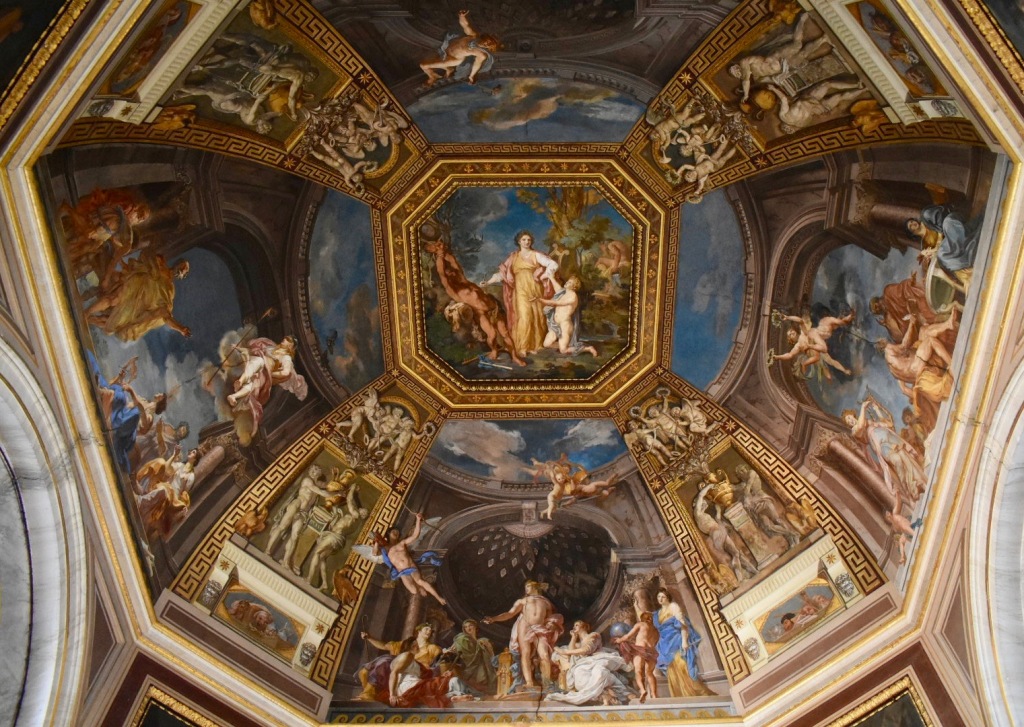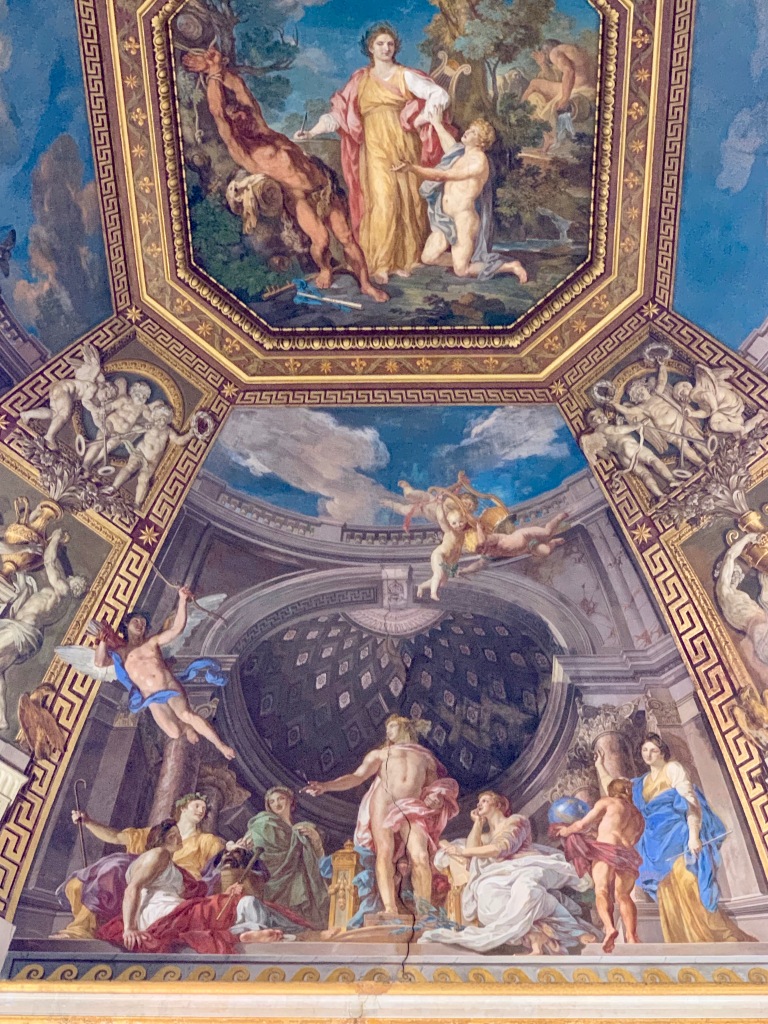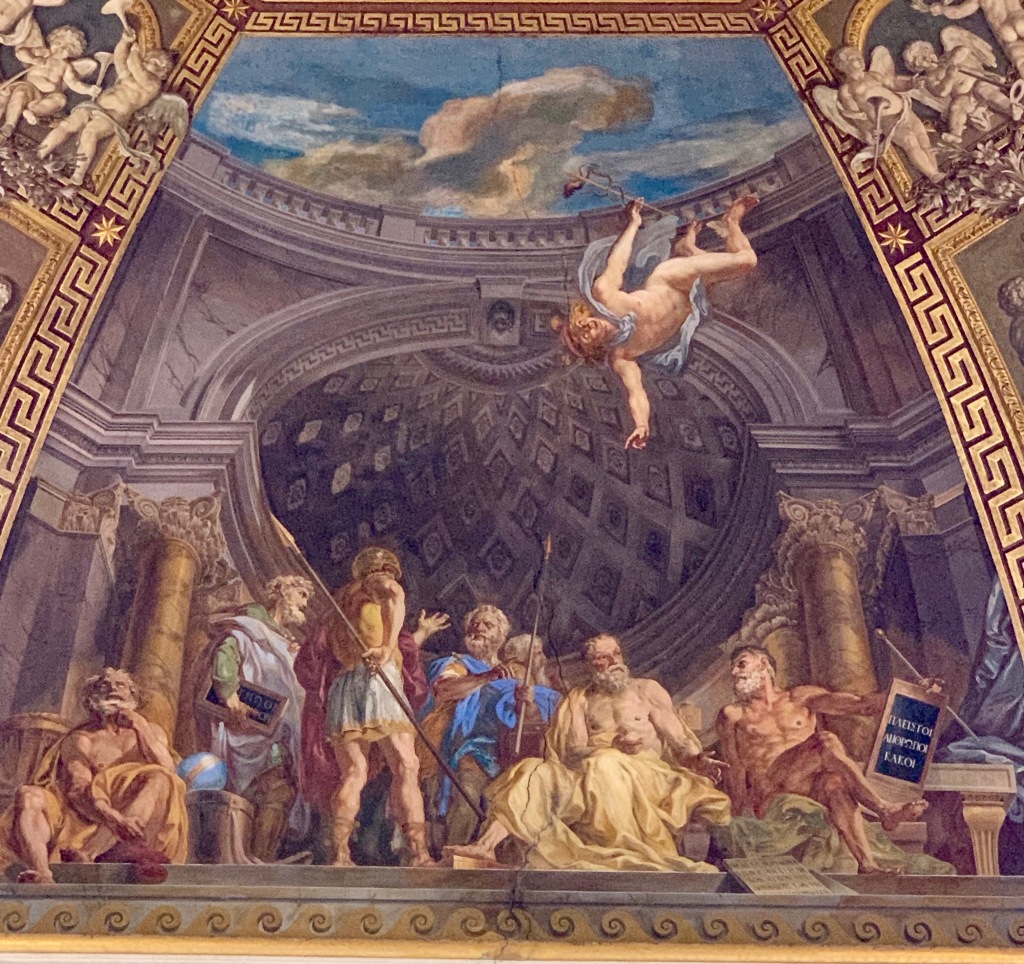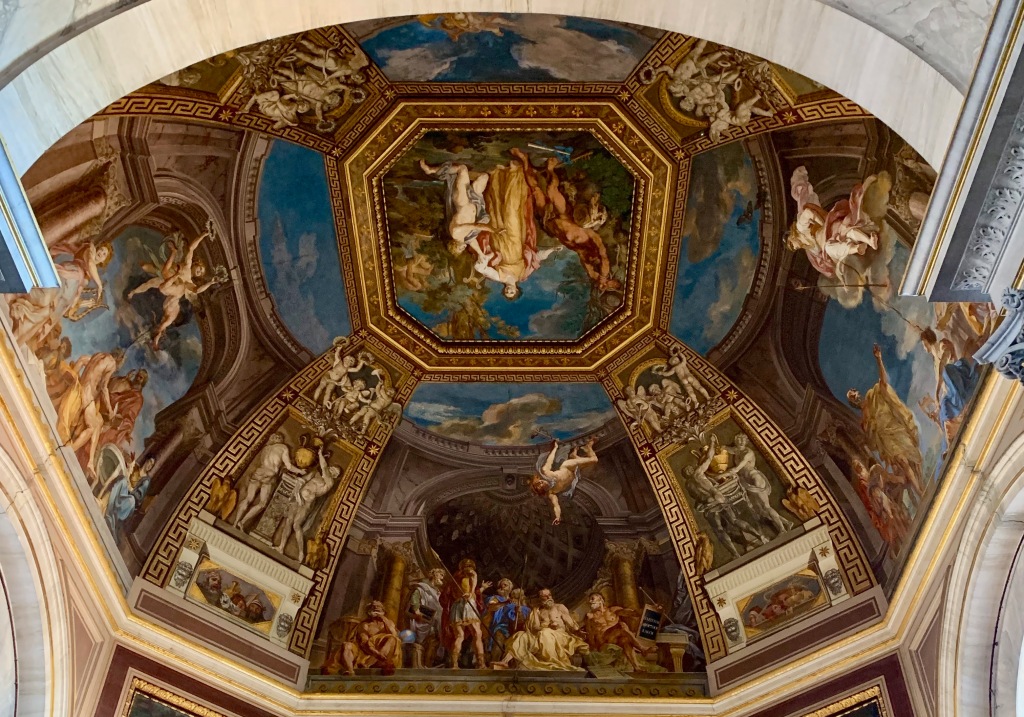In addition to the sculptures located in the Octagonal Court, the Vatican Museums are home to hundreds of other fascinating statues. I’m just going to highlight my favorite ones here, organized by museum and room.
The Pio Clementino Museum
The original papal sculptures were housed in the then Cortile delle Statue (now known as the Octagonal Court), but by the 18th century, keeping the ever-growing collection in that courtyard was no longer tenable, as the collection had dramatically increased in size over the years due to both donations and archeological excavations. Thus, Pope Clement XIV Ganganelli, followed by Pope Pius VI Braschi, converted rooms of the Belvedere Palace into a museum to house the papal collection of ancient Roman sculpture. This museum is now known as the Pio Clementino Museum, in honor of the aforementioned popes.
Hall of the Muses
The Hall of the Muses was redesigned with the intention of housing statues found at the Villa of Cassius near Tivoli (it is now commonly believed that the so-called Villa of Cassius was not actually owned by Cassius). These sculptures date from the 2nd century AD and included several (but not all nine) muses. Unfortunately, some of the sculptures found at the villa were irreparably modified by 18th century restorers in an attempt to complete the set of the nine Muses, including a sculpture that was repurposed as the muse Euterpe.
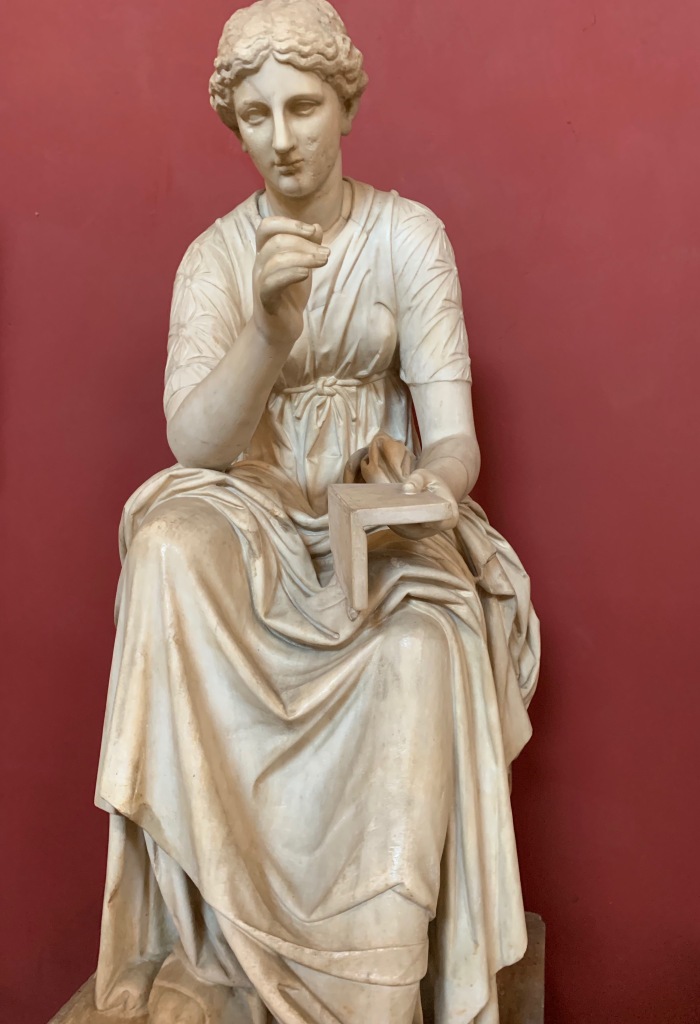
Calliope, muse of epic poetry and rhetoric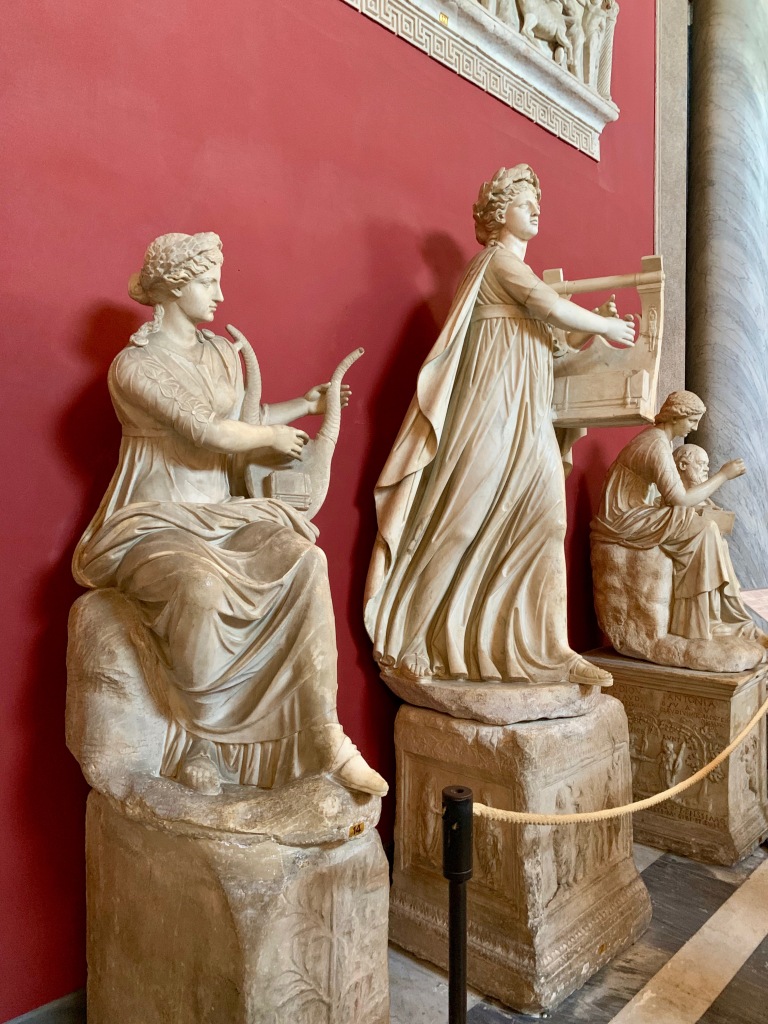
Terpsichore, muse of Dancing (seated) and the god Apollo (standing) 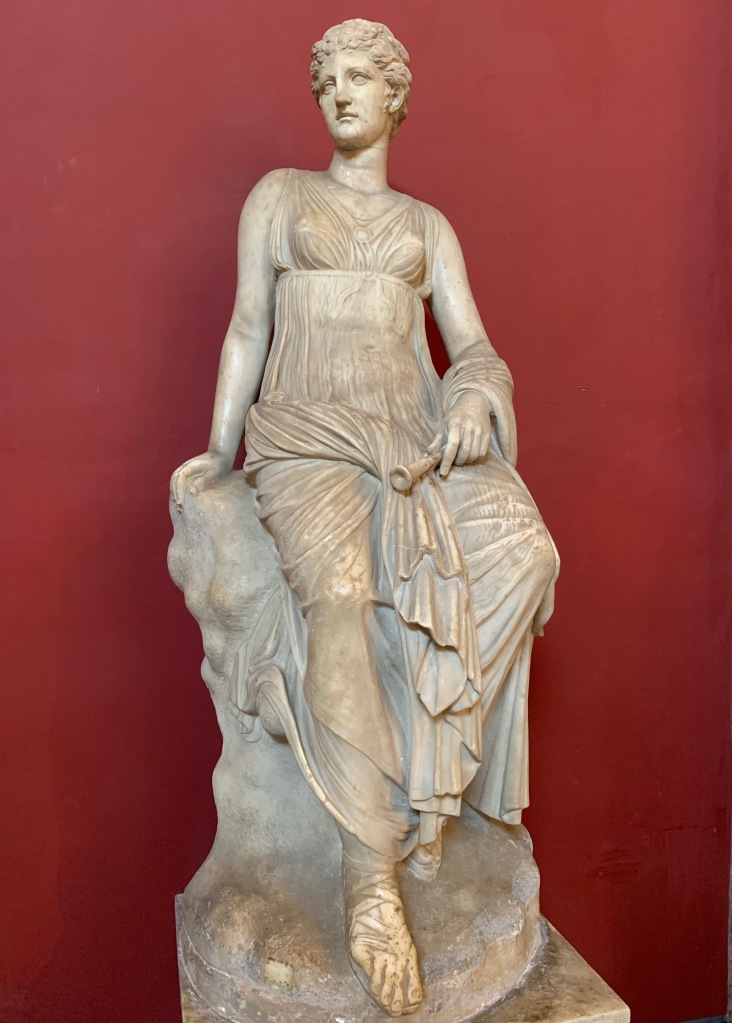
Euterpe, muse of lyric poetry
Muses were minor deities that imparted their gifts of music, poetry, and dance to men and gods, allowing both to forget their troubles by losing themselves to art. Fittingly, the Muses were the daughters of the titaness Mnemosyne (i.e. memory) and the king of the gods, Zeus.
Them in Pieria did Mnemosyne (Memory), who reigns over the hills of Eleuther, bear of union with the father, the son of Cronos, [55] a forgetting of ills and a rest from sorrow. For nine nights did wise Zeus lie with her, entering her holy bed remote from the immortals. And when a year was passed and the seasons came round as the months waned, and many days were accomplished, [60] she bore nine daughters, all of one mind, whose hearts are set upon song, and whose spirit is free from care, a little way from the top-most peak of snowy Olympus. …
For although a man has sorrow and grief in his newly-troubled soul and lives in dread because his heart is distressed, yet, when a singer, [100] the servant of the Muses, chants the glorious deeds of men of old and the blessed gods who inhabit Olympus, at once he forgets his heaviness and remembers not his sorrows at all; but the gifts of the goddesses soon turn him away from these.
Hesiod. “The Complete Hesiod Collection.” Acheron Press.
The vaulted ceiling of the hall accurately reflects the hall’s namesake. (I know this section is supposed to be about sculptures, but I couldn’t resist this ceiling, so bear with me.) Painted by Tommaso Conca, the ceiling depicts both Apollo and the Muses inspiring artistic endeavours. Apollo is included along with the Muses because he was commonly associated with music, especially with an instrument known as the lyre. According to myth, the god Hermes, the inventor of the lyre, offered it to Apollo after he had been caught stealing Apollo’s cattle.
The final, and some would argue most important, piece of the Hall of Muses is known as the Belvedere Torso. The Belvedere Torso (so called due to its original placement in the Vatican’s Belvedere Courtyard) dates from the 1st century BC and owes much of its fame to Michelangelo’s admiration of it. In fact, during and after the sixteenth century, the Belvedere Torso became the model for nudes in multiple works, including Raphael’s figure of Christ in his Vision of Ezekiel and Auguste Rodin’s The Thinker.
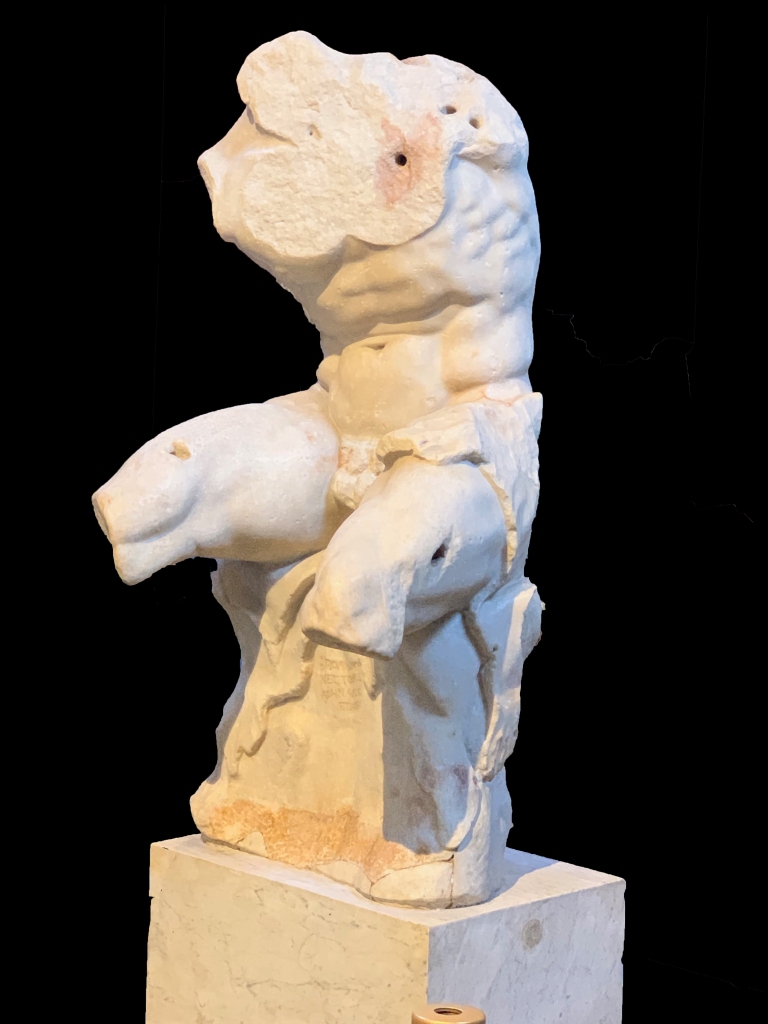
The Round Hall
The Round Hall was based off the hemispherical vault of the Pantheon. Indeed, vaulted ceiling is seemingly structurally identical (albeit a touch more ornate) to that of the famous temple to the Gods.
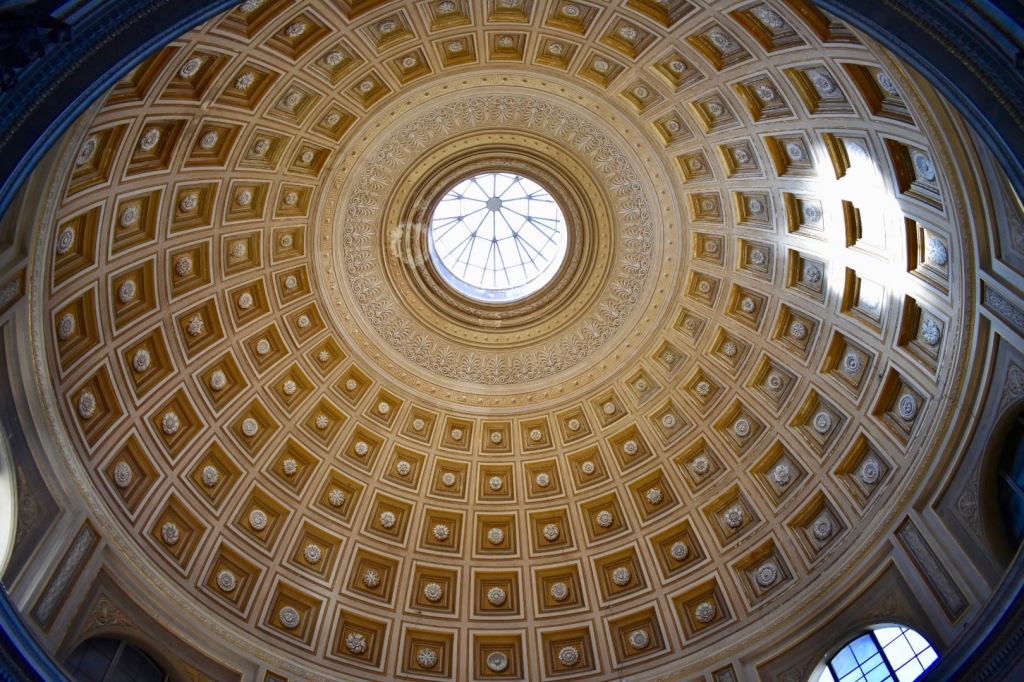
Ceiling of the Round Hall 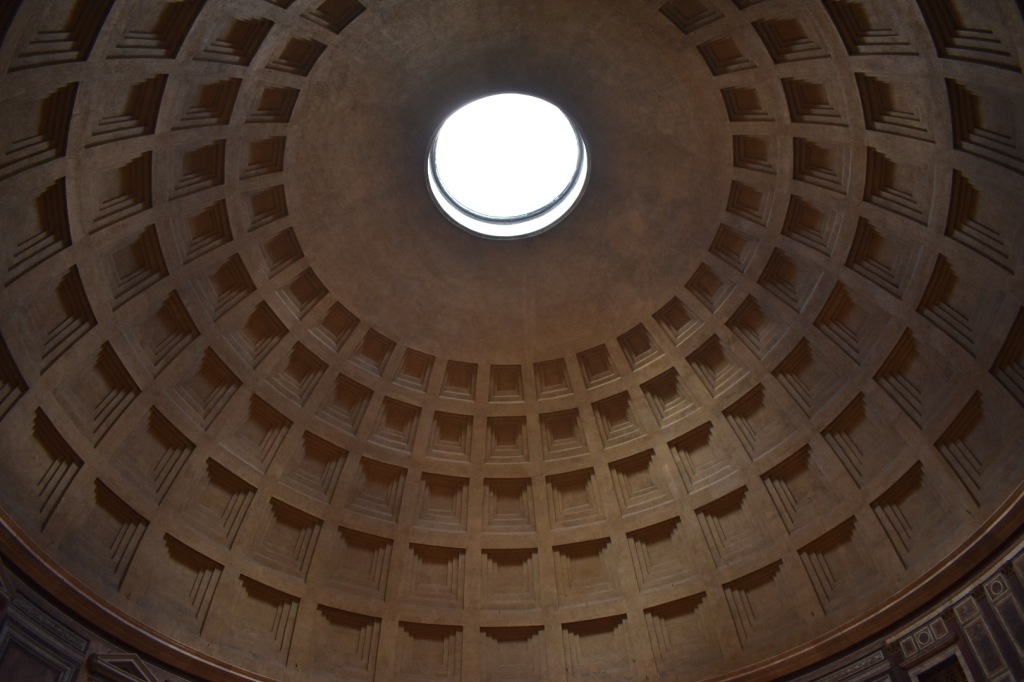
Ceiling of the Pantheon
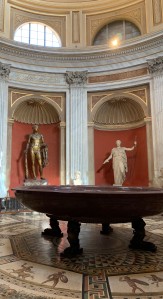
The floor mosaics of the Round Hall are from the early 3rd century AD while the porphyry basin in the center of the room is likely to have stood in an imperial Roman piazza. The gold Heracles housed in one of the niches in this room was found lying horizontally and covered by a stone with the letters F.C.S., standing for Fulgur Conditum Summanium, translated as “hidden from lightning flow.” Thus, historians have deduced that it had been given a ritual burial, which was customary for Romans to do for statues that had been hit by lightning.
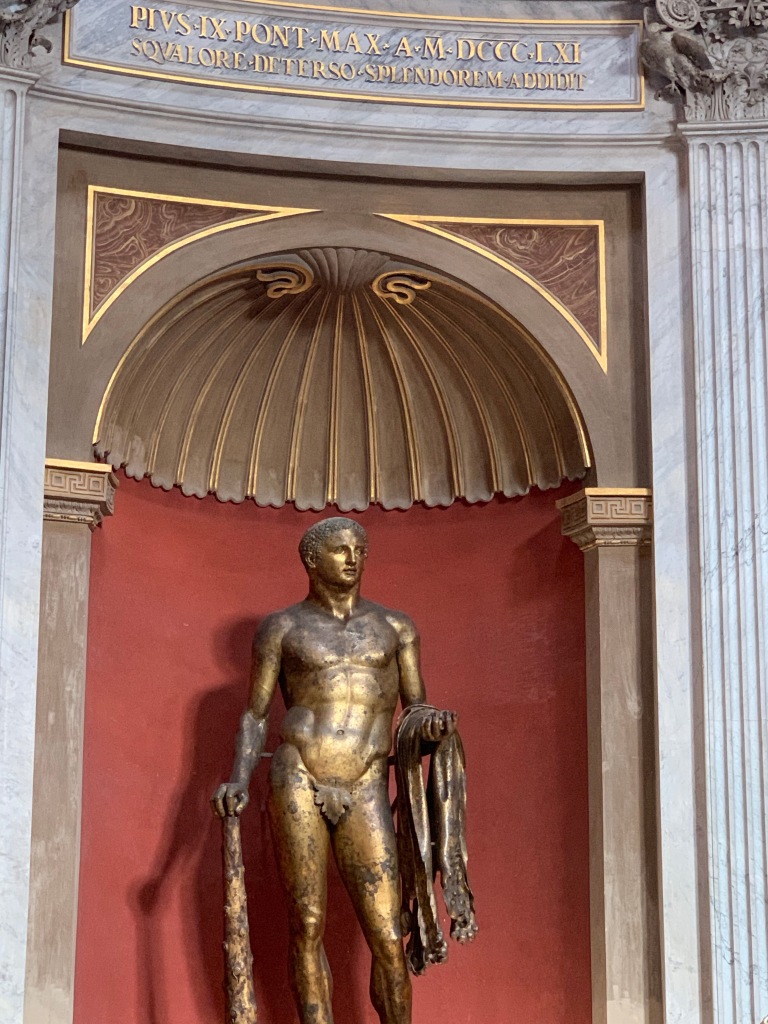
Hercules is shown in his traditional iconography: holding his club and the Nemean lion skin. (Indeed, Hercules is generally shown in this posture.)
Gallery of the Candelabra
The Gallery of the Candelabra houses The Persian Warrior, who is depicted wearing a Phrygian beret with his upper hand grasping his sword. This work is probably a Roman copy of a Greek Bronze that was made to celebrate the Greek victory over the Persians at the Battle of Marathon in 490 BC. Allegedly, an Athenian ran from Marathon to the city of Athens (about 25 miles) to deliver the news of the Persian defeat. It is this run that became the basis for the masochistic early morning, freezing races in which yours truly loves to participate. (Although, I do wish whoever came up with the idea had done his/her math better and kept the race at 25 miles rather than 26.2. For some reason, that seems much more manageable.)
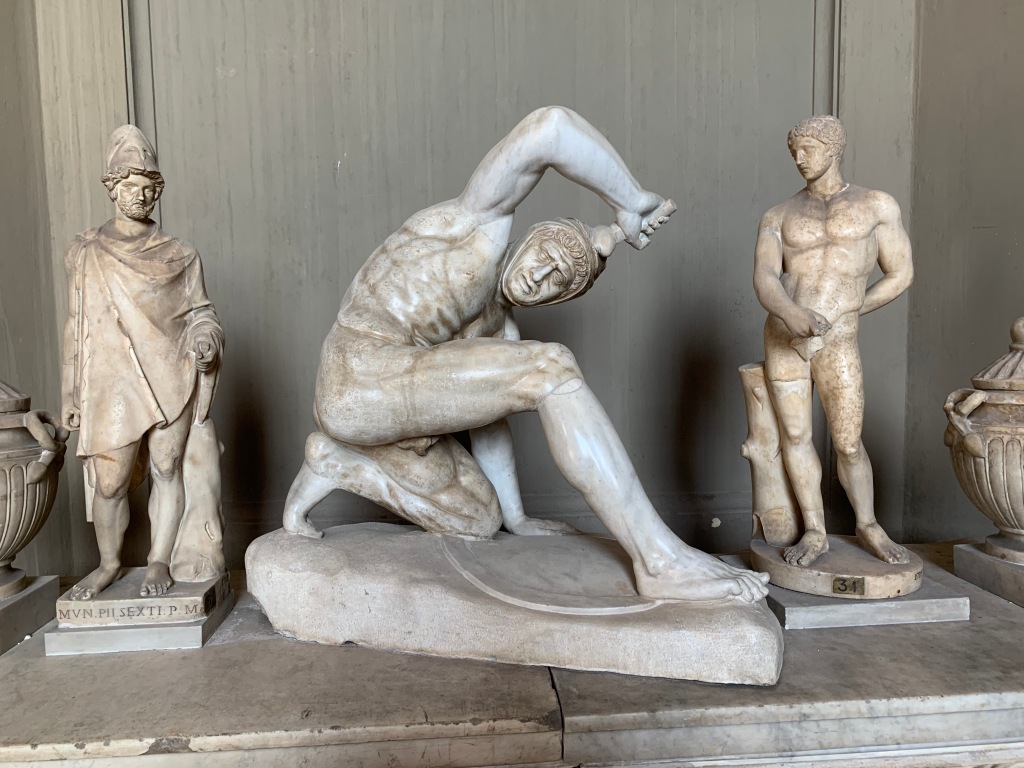
The New Wing
The New Wing was built to house the works that Napoleon had taken from the Vatican, but which France has since returned. It links the Chiaramonti Museum to the Apostolic Library and was designed to recreate the space for which the works were originally created. One of the New Wing’s most famous pieces, Augustus from Prima Porta (1st century AD), is a statue of Augustus that was found in the Villa of Livia (Livia was Augustus’ wife; for the Julio-Claudian family tree, click here).
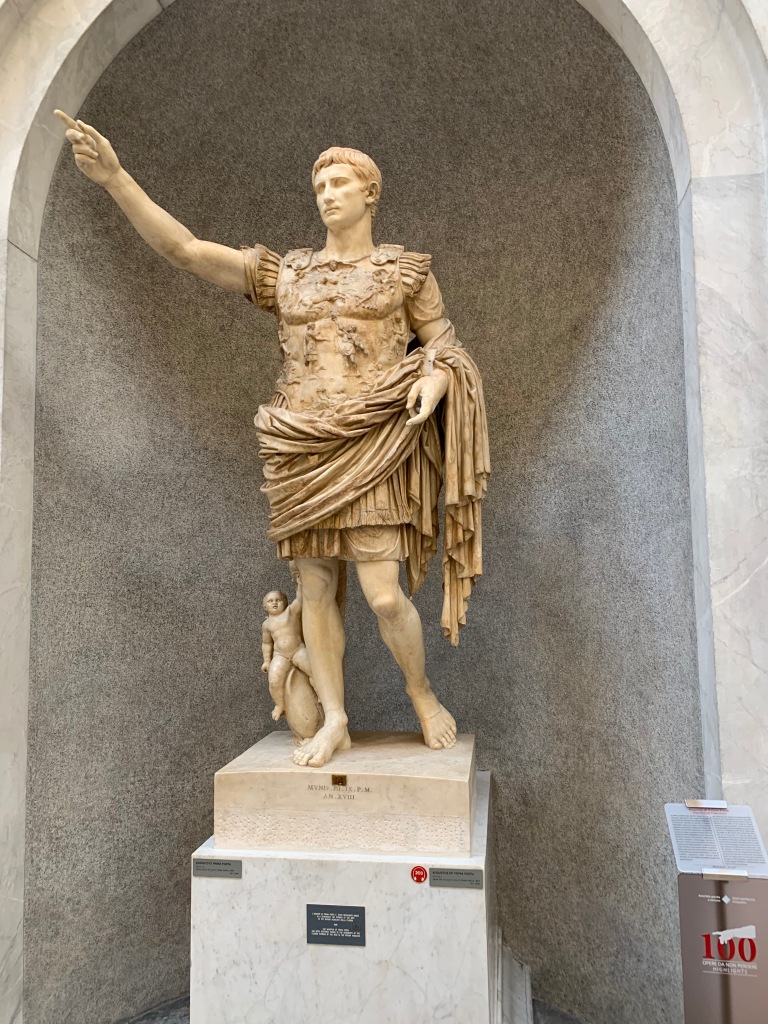
On Augustus’ cuirass (breastplate), there is a scene showing a Parthian king returning the Roman standards lost by Crassus during the Battle of Carrhae. Although the loss of a standard seems trivial to modern readers, to the superstitious ancient Romans, the loss of a standard was a monumental disaster. Therefore, Augustus’ recovery of such was a huge political victory for him, so much so that the event is commemorated on this larger than life statue. At the top of the breastplate is the personification of the Heavens and the chariots of Apollo and Aurora while at the bottom is the goddess Diana and the goddess Earth, symbolizing divine sanction of Augustus’ rule.
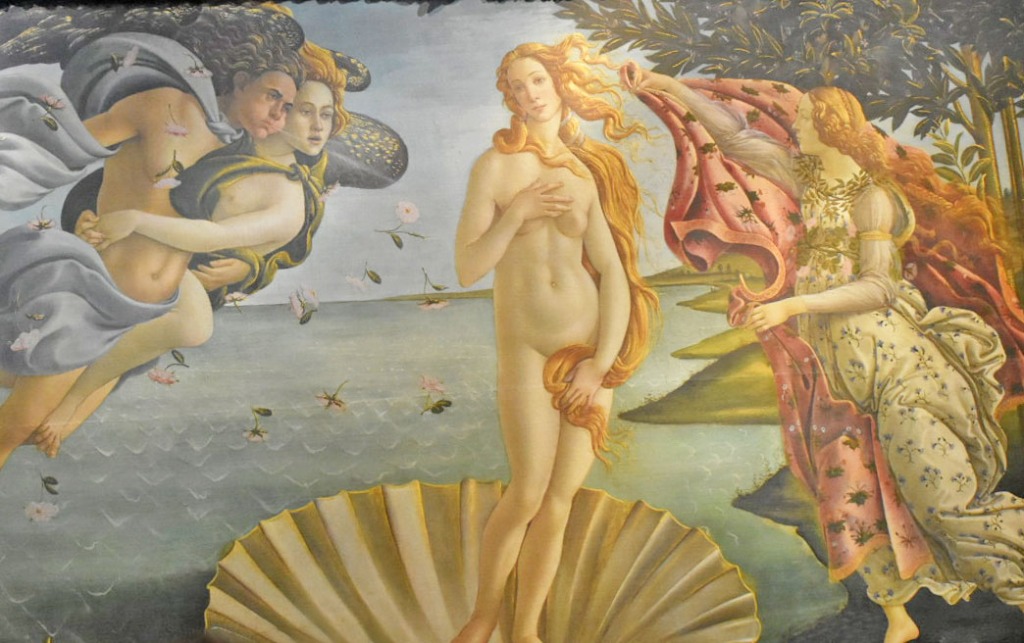
Notice the weird baby attached to Augustus’ leg? Well that weird baby was likely designed to promote Augustus’ supposed divine descent from the goddess Venus. Historians have identified the baby as Cupid, Venus’ son, in part, because he is riding a dolphin, an animal closely linked to Venus, who in one myth is born of the sea (see Sandro Botticelli’s Birth of Venus, to the left of this text, which will hopefully be featured in an upcoming post about the Uffizi).
The Julii clan (i.e. the family of Julius Caesar and his grand-nephew/adopted son, Augustus) claimed descent from the Trojan Aeneas, who himself was alleged to have descended from the goddess Venus. And therefore, Venus’ son Cupid was likely included in this piece to emphasize Augustus’ links to divinity.
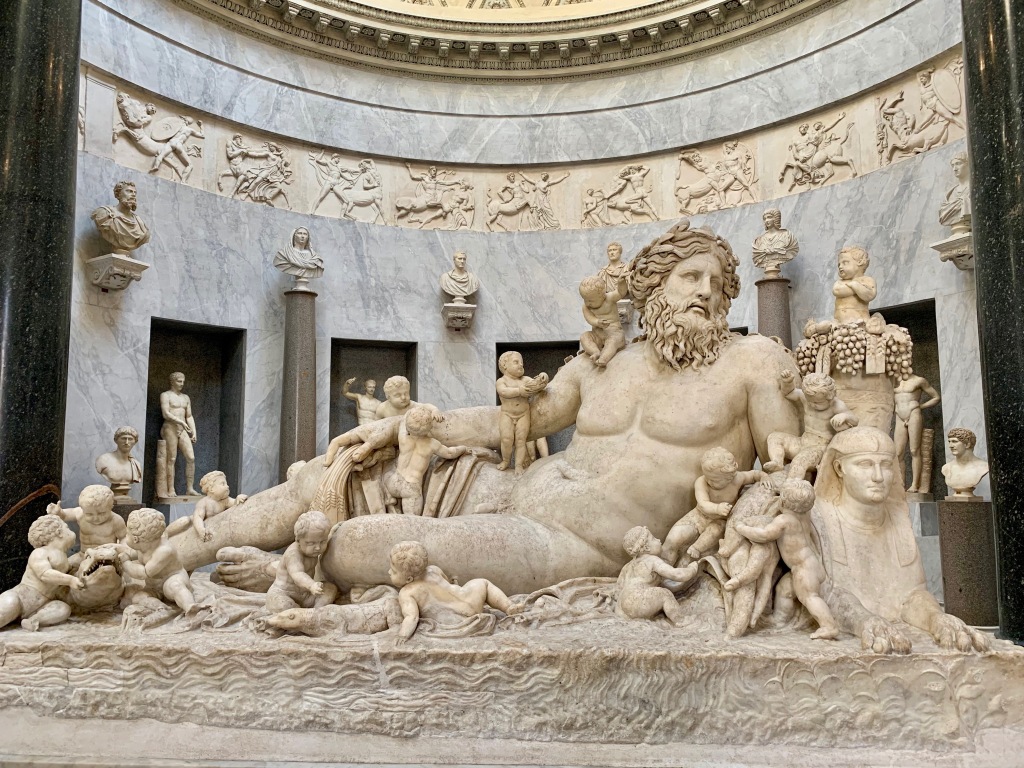
The Nile is a 1st century AD Roman copy of a Greek original. The work personifies the River Nile as an old man while Egypt is represented by a sphinx, supporting the Nile. Sixteen children run along the top of the Nile; according to Roman historian Pliny the Elder, the children represent the sixteen cubits of water by which the Nile rises for its annual flood. Interestingly, this piece was at the center of an international debacle between Italy and France during the early nineteenth century. As it turns out, Emperor Napoleon was quite fond of Italian art, and during his invasion of Italy, he commandeered several pieces (including the Nile) and sent them to the Louvre. After Napoleon’s defeat at Waterloo, the Pope demanded that the French return the artwork to the Vatican. The French, reluctant to give back this treasure, offered the Pope a nude statute of Napoleon as compensation. The Pope, obviously not keen to own a colossal nude statute of an overthrown foreign invader, declined the offer and demanded the Nile back. As evidenced, the French acquiesced.
Also here is a statue of Silenus and the baby Dionysus (yes, that Dionysus; even gods of wine and the bacchanal were babies at one point). In a tribute to the baby’s eventual celestial purview, the branch supporting the two is decorated with grape vines. Silenus is variously described as Dionysus’ foster father, companion, and/or tutor, depending on the source. This statue, as usual, is a Roman copy of a Greek original (the ancient Romans had some serious appropriation issues – stealing myths, artwork, etc), and it dates from around the 2nd century AD.
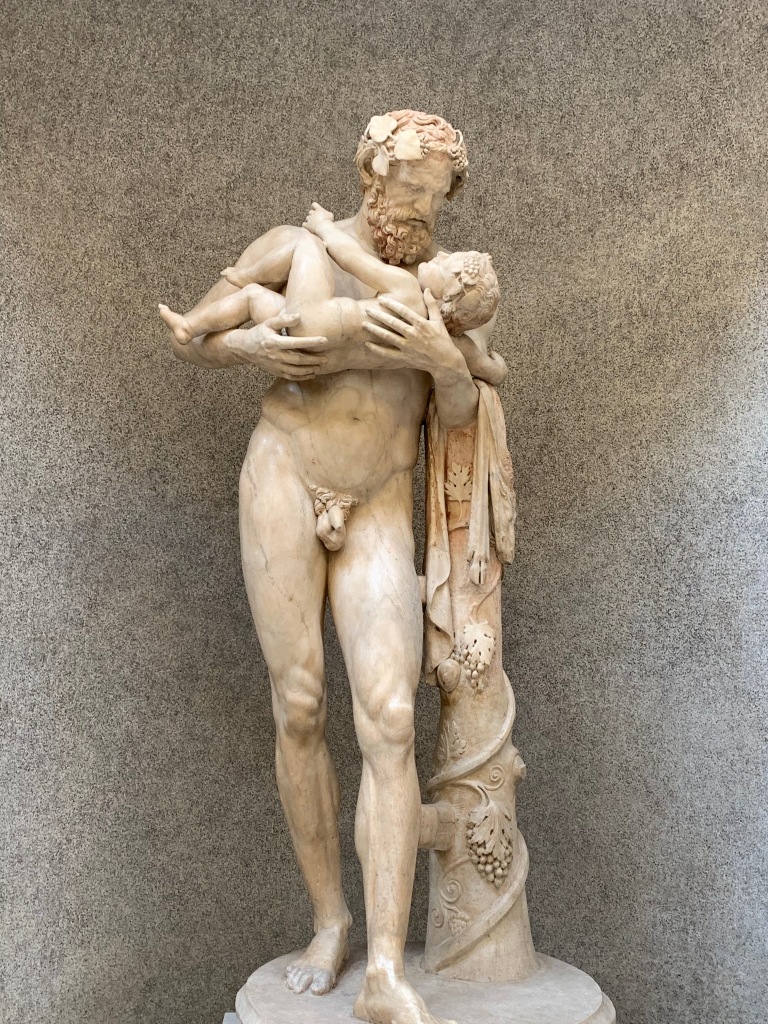
I hope you enjoyed some of my favorite pieces from the Vatican. Thanks as always for reading!
